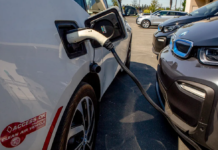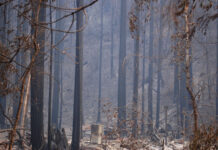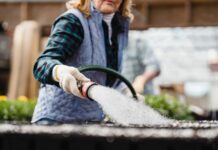
Hospitals are at capacity. COVID-19 infections are at record highs. Testing lines stretch for hours. Yet even as the omicron variant batters the state, only 38% of vaccinated Californians have gotten a booster shot.
As with initial vaccinations, acceptance of the booster shot has varied throughout California: Counties in the far north and rural areas continue to see lower numbers, with as few as 23% of vaccinated people getting a booster in Mariposa, Colusa and Merced counties, according to a CalMatters analysis of state data.
The Bay Area boasts the highest rate, at 55%, and only three counties have more than half of their vaccinated population boosted: San Francisco, Marin and San Mateo. In 19 California counties, less than a third of eligible residents are boosted.
In Sonoma County, data from the California Department of Public Health shows that 46.9% of vaccinated people have received their booster.
In Imperial County — the border community that led the state in vaccination rates last spring after it was hit hard by the virus — only a quarter of eligible residents have gotten a booster shot. The health officer there blames “pandemic fatigue.”
“I do think there’s been some fatigue after nearly two years of this pandemic, not just in Imperial County, but everywhere,” said Health Officer Dr. Stephen Munday. “People want to get back to their normal lives. They want to go to work, they want to take care of their families. It’s kind of like, well, gosh, I got my two doses, why do I have to get another one?”
It’s not just people in rural counties where a majority of people have refused so far to get the extra shot: Los Angeles, Kern and Santa Barbara and 28 other countieshave lower booster rates than the 38% statewide average. Major population centers such as San Diego, San Bernardino and Riverside are lagging behind.
State and federal recommendations for booster shots have changed several times, making them difficult for the public to follow. Current guidance advises a booster for all adults, while children as young as 12 can only get an additional Pfizer shot. Immunocompromised children as young as 5 are also eligible for another Pfizer dose.
Studies show an additional dose can double protection against infection and is highly effective in preventing severe disease and hospitalization even against the omicron variant, said UC San Francisco epidemiologist George Rutherford.
“Run, don’t walk, to go get your boosters,” Fresno County Health Officer Dr. Rais Vohra said.
Most older adults throughout the state have listened to the advice: Nearly 64% have been boosted.In Marin County, as many as 80% of those 65 and older have been boosted, and only four counties have boosted fewer than half of their older population.
But for younger Californians, getting an additional dose is far less common. Only 47% of those aged 50-64 have been boosted. Forty-four counties have boosted less than half their population in this age group.
“The case spikes are being driven by the unvaccinated, which are 25 to 45 years old, largely,” Rutherford said. “That’s where we’re seeing the majority of cases, and that’s where the majority of unvaccinated or under-vaccinated people are.”
Unlike early in the pandemic when vaccines were limited, the slow booster uptake has little to do with availability. “There’s a very robust supply,” said Imperial County Health Officer Munday.
According to the state health department, the state stockpile currently has 5.6 million available doses — a 39-day supply. MyTurn, the state’s vaccination portal, recently added booster appointments for children ages 12-15.
“Omicron is here. We can’t abandon the tools that have allowed California to be one of the safest states throughout the pandemic. Those are vaccines and boosters,” Health and Human Services Secretary Dr. Mark Ghaly said during an update Wednesday.
All-patient hospitalizations are approaching 51,000 people, a number just shy of the peak capacity reached during last winter’s surge. Approximately 8,000 of those patients are COVID-19 cases.
“To those who haven’t been vaccinated at all: Get your vaccine as quickly as you can. And those who have been vaccinated but haven’t been boosted, please consider getting boosted,” Ghaly said.
In Fresno, where COVID-19 has prompted deployment of the National Guard, many health care workers are unable to work due to COVID-19 exposure or infection, further straining their hospital system, officials said.
Only a third of eligible residents in Fresno County are currently boosted, according to state data.
“The boosted vaccination population is fending off the omicron infections really quickly,” Vohra said. “For the unvaccinated folks they basically are the ones who are super vulnerable and those are the ones we’re worried about because they’re the ones that land in the hospitals and ICU.”
North of Fresno, officials in sparsely populated Mariposa County are relying heavily on the state’s MyTurn portal to distribute booster shots. Less than a quarter of eligible residents have been boosted.
County Health Officer Dr. Eric Sergienko said mass vaccination clinics have subsided due to decreased demand, fewer resources and privacy concerns in their small community.
“Rather than doing clinics with hundreds, we have clinics through MyTurn that are booked out with 30 to 100 people at our scheduled clinics on Tuesdays and Thursday,” Sergienko said.
Cases and hospitalizations in Mariposa County have trended younger with a majority of cases occurring among those ages 20-40 and a majority of hospitalizations among unvaccinated people ages 40 to 55, department spokeswoman Lizz Darcy said.
The statewide surge in infections and hospitalizations is expected to peak during the third week of January, experts say. Hospitalizations remain substantially below pre-vaccine levels.
Community organizations and health centers, which have been at the forefront of vaccine education and distribution, say interest in the booster has increased during this current surge.
“It seems our community is much more receptive to receiving the booster than they were originally to get the first dose,” said Bryant Macias, emergency relief supervisor at the United Farmworkers Foundation, which has advocated for priority doses for farmworkers and helped organize clinics.
“The main challenges we have identified are individuals not knowing how long they need to wait before getting the booster shot, whether or not they can get a booster that is different from their initial vaccine, and some folks only wanting the booster if it’s the same kind as their initial dose.”
In agricultural counties, like those in the Central Valley, workplace vaccine clinics played an important role in increasing access last spring. Those events for boosters may not be as visible yet because it’s the off season for many crops. But they’re in the plans, said Irene de Barraicua, director of operations with Lideres Campesinas, a nonprofit network of farm workers based in Oxnard.
“We’ve heard from counties and workgroups that are enthusiastic about continuing these efforts,” she said.
Additional reporting by Zoë Strickland.
SoCoNews is partnering with CalMatters to provide a wider variety of news that gives our readers national and regional context for issues facing our local communities.







